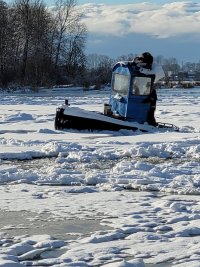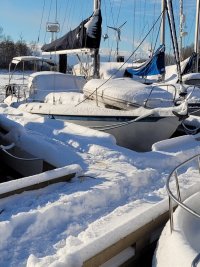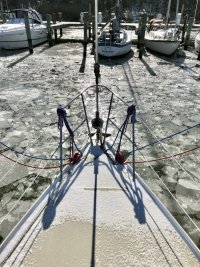In Rochester, we haul out every fall and store "on the hard" from late October until late April. We've stored on jacks (which the PO used at his yard in Erie, PA) and on a cradle (our yard crew modified one that had been abandoned). We've stored with the mast up, and the mast down, but always outdoors. In our area, hauling out and storing is assumed.
We have a cover that has served well (new in 2005, to be replaced soon). During the winter, we can get some pretty high wind gusts (50+ miles/hr), and we get 100" of snow a year. For the first couple of years, we had the boat professionally winterized, but as we gained more experience, we realized that the pro was leaving out quite a few of the recommendations in the Ericson owner's manual, so we took over the tasks. We've had the boat for six years now, and winterizing has become pretty routine; we were real newbies when we started. Without the cover, the snow would accumulate, melt, and freeze, causing all kinds of anxiety, if not complications. I think the anxiety about winter weather (snow, wind, freezing) might be higher for us if the boat were in the water, uncovered. And the idea of walking an icy dock or deck in a winter storm to check on the boat or remove accumulating snow doesn't appeal to yours truly.
Some advantages to winter storage for us (under a cover): we remove all the running rigging and run cheap messenger lines, which protects expensive cordage from the winter ravages of UV (canvas and brightwork also get a six month break from the UV); we work on projects over the winter and in the spring that are easier to tackle with the boat out of the water; we freshen the bottom paint every spring, and we get a good wax/polish on the hull that is keeping that gel coat in fine condition.
We do have the advantage of being stored in the parking lot at our club, which means there is electricity available, when needed, and there are others who keep an eye out as they are working on their own boats. We do check on the boat regularly during the winter. The first year, it was a weekly check-up (I was so excited!). Now it's every month or so, unless there's some kind of weather incident.



